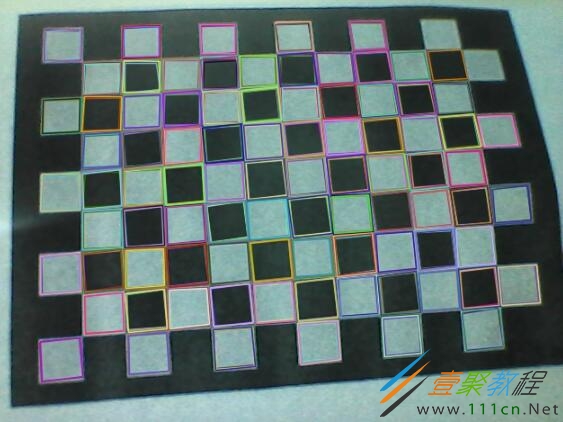最新下载
热门教程
- 1
- 2
- 3
- 4
- 5
- 6
- 7
- 8
- 9
- 10
opencv如何实现矩形检测 opencv实现矩形检测代码实例
时间:2022-06-25 04:29:44 编辑:袖梨 来源:一聚教程网
opencv如何实现矩形检测?本篇文章小编给大家分享一下opencv实现矩形检测代码实例,文章代码介绍的很详细,小编觉得挺不错的,现在分享给大家供大家参考,有需要的小伙伴们可以来看看。
代码如下:
#include "cv.h" #include "highgui.h" #include#include #include ////////////////////////////////////////////////////////////////// //函数功能:用向量来做COSα=两向量之积/两向量模的乘积求两条线段夹角 //输入: 线段3个点坐标pt1,pt2,pt0,最后一个参数为公共点 //输出: 线段夹角,单位为角度 ////////////////////////////////////////////////////////////////// double angle( CvPoint* pt1, CvPoint* pt2, CvPoint* pt0 ) { double dx1 = pt1->x - pt0->x; double dy1 = pt1->y - pt0->y; double dx2 = pt2->x - pt0->x; double dy2 = pt2->y - pt0->y; double angle_line = (dx1*dx2 + dy1*dy2)/sqrt((dx1*dx1 + dy1*dy1)*(dx2*dx2 + dy2*dy2) + 1e-10);//余弦值 return acos(angle_line)*180/3.141592653; } ////////////////////////////////////////////////////////////////// //函数功能:采用多边形检测,通过约束条件寻找矩形 //输入: img 原图像 // storage 存储 // minarea,maxarea 检测矩形的最小/最大面积 // minangle,maxangle 检测矩形边夹角范围,单位为角度 //输出: 矩形序列 ////////////////////////////////////////////////////////////////// CvSeq* findSquares4( IplImage* img, CvMemStorage* storage ,int minarea, int maxarea, int minangle, int maxangle) { CvSeq* contours;//边缘 int N = 6; //阈值分级 CvSize sz = cvSize( img->width & -2, img->height & -2 ); IplImage* timg = cvCloneImage( img );//拷贝一次img IplImage* gray = cvCreateImage( sz, 8, 1 ); //img灰度图 IplImage* pyr = cvCreateImage( cvSize(sz.width/2, sz.height/2), 8, 3 ); //金字塔滤波3通道图像中间变量 IplImage* tgray = cvCreateImage( sz, 8, 1 ); ; CvSeq* result; double s, t; CvSeq* squares = cvCreateSeq( 0, sizeof(CvSeq), sizeof(CvPoint), storage ); cvSetImageROI( timg, cvRect( 0, 0, sz.width, sz.height )); //金字塔滤波 cvPyrDown( timg, pyr, 7 ); cvPyrUp( pyr, timg, 7 ); //在3个通道中寻找矩形 for( int c = 0; c < 3; c++ ) //对3个通道分别进行处理 { cvSetImageCOI( timg, c+1 ); cvCopy( timg, tgray, 0 ); //依次将BGR通道送入tgray for( int l = 0; l < N; l++ ) { //不同阈值下二值化 cvThreshold( tgray, gray, (l+1)*255/N, 255, CV_THRESH_BINARY ); cvFindContours( gray, storage, &contours, sizeof(CvContour),CV_RETR_LIST, CV_CHAIN_APPROX_SIMPLE, cvPoint(0,0) ); while( contours ) { //多边形逼近 result = cvApproxPoly( contours, sizeof(CvContour), storage,CV_POLY_APPROX_DP, cvContourPerimeter(contours)*0.02, 0 ); //如果是凸四边形并且面积在范围内 if( result->total == 4 && fabs(cvContourArea(result,CV_WHOLE_SEQ)) > minarea && fabs(cvContourArea(result,CV_WHOLE_SEQ)) < maxarea && cvCheckContourConvexity(result) ) { s = 0; //判断每一条边 for( int i = 0; i < 5; i++ ) { if( i >= 2 ) { //角度 t = fabs(angle( (CvPoint*)cvGetSeqElem( result, i ),(CvPoint*)cvGetSeqElem( result, i-2 ),(CvPoint*)cvGetSeqElem( result, i-1 ))); s = s > t ? s : t; } } //这里的S为直角判定条件 单位为角度 if( s > minangle && s < maxangle ) for( int i = 0; i < 4; i++ ) cvSeqPush( squares,(CvPoint*)cvGetSeqElem( result, i )); } contours = contours->h_next; } } } cvReleaseImage( &gray ); cvReleaseImage( &pyr ); cvReleaseImage( &tgray ); cvReleaseImage( &timg ); return squares; } ////////////////////////////////////////////////////////////////// //函数功能:画出所有矩形 //输入: img 原图像 // squares 矩形序列 // wndname 窗口名称 //输出: 图像中标记矩形 ////////////////////////////////////////////////////////////////// void drawSquares( IplImage* img, CvSeq* squares ,const char* wndname) { CvSeqReader reader; IplImage* cpy = cvCloneImage( img ); CvPoint pt[4]; int i; cvStartReadSeq( squares, &reader, 0 ); for( i = 0; i < squares->total; i += 4 ) { CvPoint* rect = pt; int count = 4; memcpy( pt, reader.ptr, squares->elem_size ); CV_NEXT_SEQ_ELEM( squares->elem_size, reader ); memcpy( pt + 1, reader.ptr, squares->elem_size ); CV_NEXT_SEQ_ELEM( squares->elem_size, reader ); memcpy( pt + 2, reader.ptr, squares->elem_size ); CV_NEXT_SEQ_ELEM( squares->elem_size, reader ); memcpy( pt + 3, reader.ptr, squares->elem_size ); CV_NEXT_SEQ_ELEM( squares->elem_size, reader ); //cvPolyLine( cpy, &rect, &count, 1, 1, CV_RGB(0,255,0), 3, CV_AA, 0 ); cvPolyLine( cpy, &rect, &count, 1, 1, CV_RGB(rand()&255,rand()&255,rand()&255), 1, CV_AA, 0 );//彩色绘制 } cvShowImage( wndname, cpy ); cvReleaseImage( &cpy ); } int main() { CvCapture* capture = cvCreateCameraCapture(0); IplImage* img0 = 0; CvMemStorage* storage = 0; int c; const char* wndname = "Square Detection Demo"; //窗口名称 storage = cvCreateMemStorage(0); cvNamedWindow( wndname, 1 ); while (true) { img0 = cvQueryFrame(capture); drawSquares( img0, findSquares4( img0, storage, 100, 2000, 80, 100), wndname ); cvClearMemStorage( storage ); //清空存储 c = cvWaitKey(10); if( c == 27 ) break; } cvReleaseImage( &img0 ); cvClearMemStorage( storage ); cvDestroyWindow( wndname ); return 0; }
效果:















